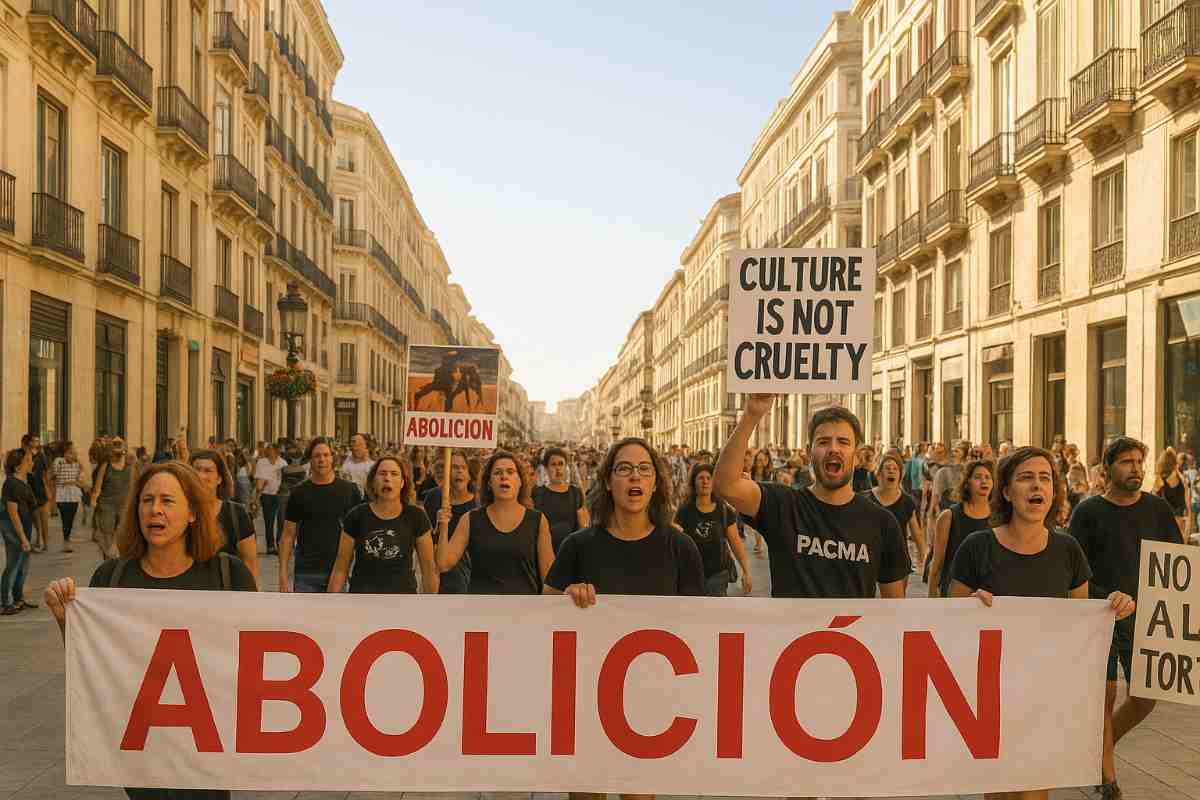Anti-bullfighting protests are gaining strength in Andalusia. In Malaga, activists recently marched on Calle Larios to call for an end to corridas, reflecting shifting values across Spain.

Last Sunday, the heart of Malaga was filled not with music or festival parades, but with voices of protest. As I walked along Calle Larios, the city’s most iconic street, I found myself in the middle of a demonstration calling for an end to bullfighting. Activists held banners high, chanting against a practice they described as cruel, outdated, and unworthy of a modern Spain. It was a striking scene that reflected a wider shift happening across Andalusia.
A growing phenomenon in Andalusia
Anti-bullfighting protests are not new, but they are becoming more frequent and more visible across southern Spain. Marbella, Seville, Granada, and especially Malaga have seen an increase in demonstrations over the past few years. These events are often organized by groups like PACMA (Partido Animalista Con el Medio Ambiente) and supported by smaller local collectives who campaign for animal rights.
Traditionally, protests have taken place in front of bullrings such as La Malagueta in Malaga or the historic arenas in Seville. Yet the fact that activists are now moving their demonstrations into central urban spaces like Calle Larios signals a change of strategy. It is no longer about confronting only the bullfighting institutions, but about raising awareness among everyday citizens, shoppers, and tourists who may not otherwise encounter the issue.
Calle Larios: a protest in the city’s most popular street
Calle Larios is often described as Malaga’s living room. It is where locals gather during Christmas to admire the light displays, where processions pass during Semana Santa, and where visitors stroll during summer evenings. To see it transformed into a stage for protest against bullfighting was powerful.
The demonstration I witnessed was small in numbers (perhaps a few dozen activists) but strong in conviction. They carried banners with slogans against bullfighting. These banners, accompanied by shouted slogans and people encouraging people to sign petitions, attracted curious onlookers who stopped to film, ask questions, or simply observe.
I have to admit, I don’t usually feel aligned with every activist cause I come across. But in this particular case, I found myself in agreement. Bullfighting, for all its tradition and spectacle, strikes me as a practice that no longer fits within the values of a modern and compassionate society. Seeing the protesters take their message to the very centre of Malaga’s public life made the issue difficult to ignore.
Who are the protesters?
Groups like PACMA have been at the forefront of anti-bullfighting efforts nationwide, demanding that public funding for corridas be eliminated and that arenas be transformed into cultural or community spaces. Locally in Malaga, smaller networks of animal rights advocates often collaborate on these demonstrations.
What is interesting is that these groups are not limited to international activists or “self-righteous expats,” as critics sometimes suggest. The majority are Spaniards, many of them young, who see bullfighting less as cultural heritage and more as unnecessary suffering. Their presence challenges the stereotype that opposition comes mainly from outside Spain.
Tradition versus change
Bullfighting advocates are fiercely campaigning for its preservation, presenting it as an art form with a centuries-old history. They emphasize its role in Andalusian identity, tourism, and employment. Indeed, during the Feria de Málaga in August, the La Malagueta bullring continued to draw large crowds, filling the stands with locals and tourists applauding the spectacle. I myself had the opportunity to attend one of the bullfights out of curiosity, and it was there that I understood the reason for these protests. While the atmosphere itself was interesting, I disapprove of this treatment of animals for the sake of entertainment.
The growing number of protests, like the one I witnessed on Calle Larios, suggests that the cultural consensus is shifting. Opinion polls consistently show a decline in support for bullfighting, particularly among younger Spaniards. Cities declaring themselves ciudades antitaurinas (officially opposed to bullfighting) further underscore this shift.
What the future may hold
It is difficult to predict how quickly bullfighting might decline in Andalusia. The practice remains protected by law as part of Spain’s cultural heritage, and powerful economic interests continue to back it. Still, the symbolic weight of protests on Malaga’s busiest street shows that resistance is no longer confined to the fringes.
For me, the experience of stumbling upon this demonstration on Calle Larios was a reminder that Malaga is a city in transition. It is proud of its history and traditions, but also increasingly shaped by new values, global perspectives, and a younger generation demanding change.
Bullfighting may not disappear overnight, but every chant, every banner, and every gathering of protesters brings the debate closer to the mainstream. And as Andalusia balances tradition with modernity, it is clear that voices calling for compassion are becoming harder to ignore.
